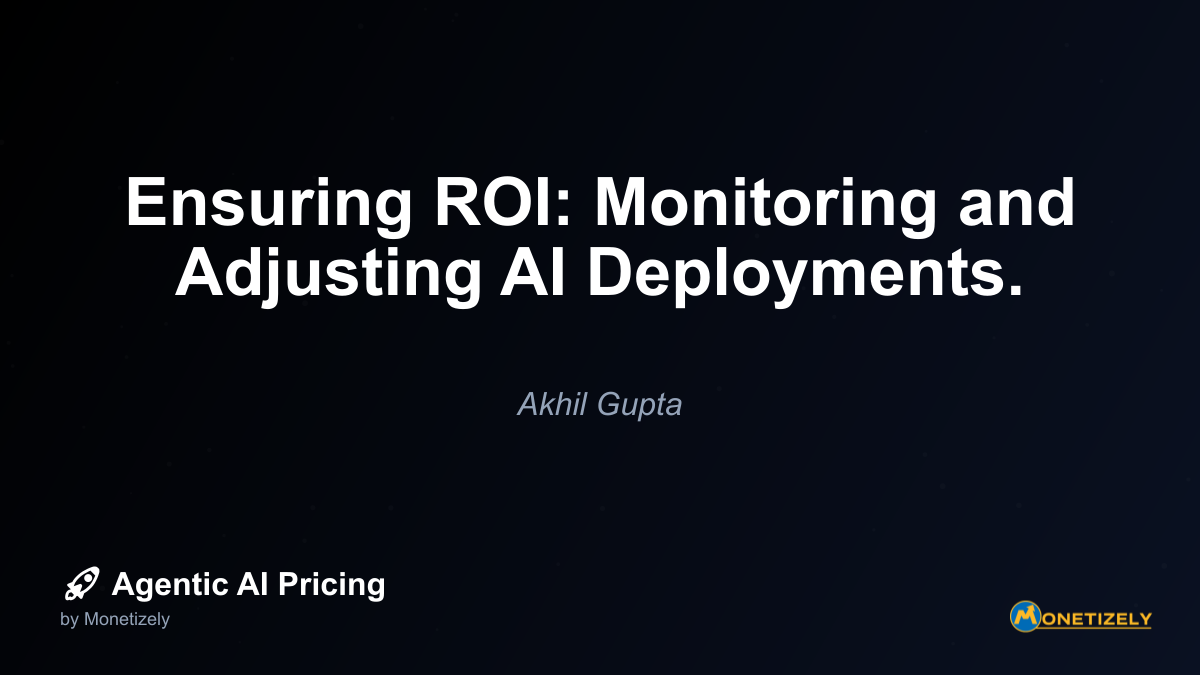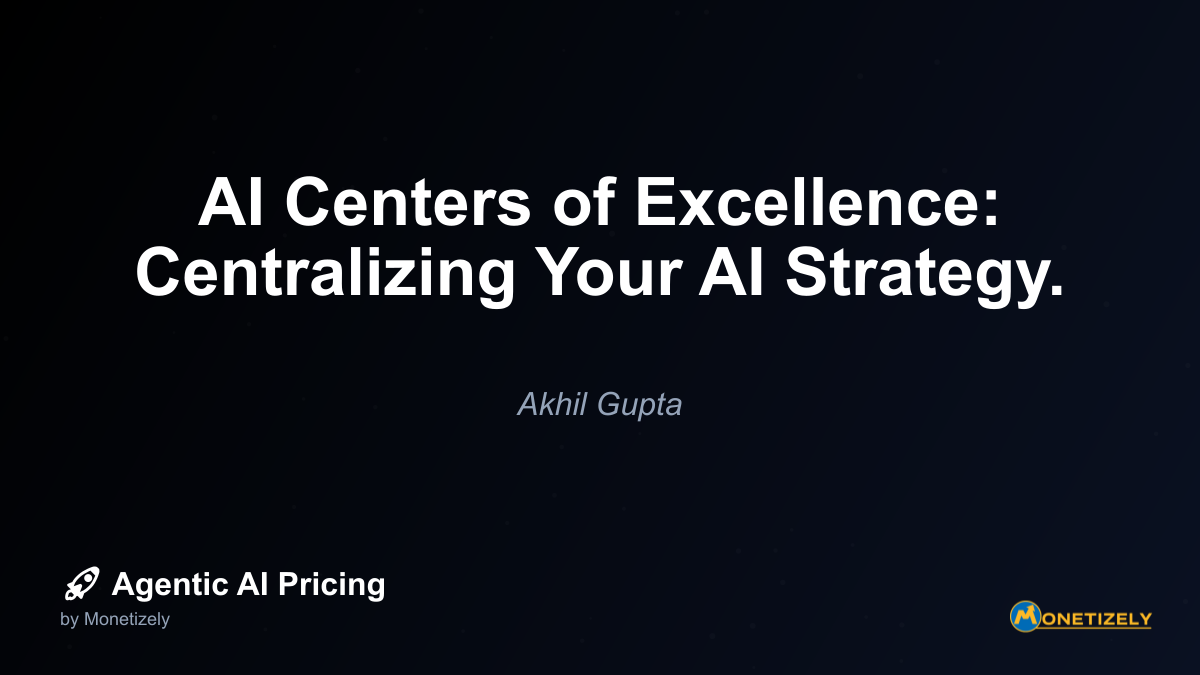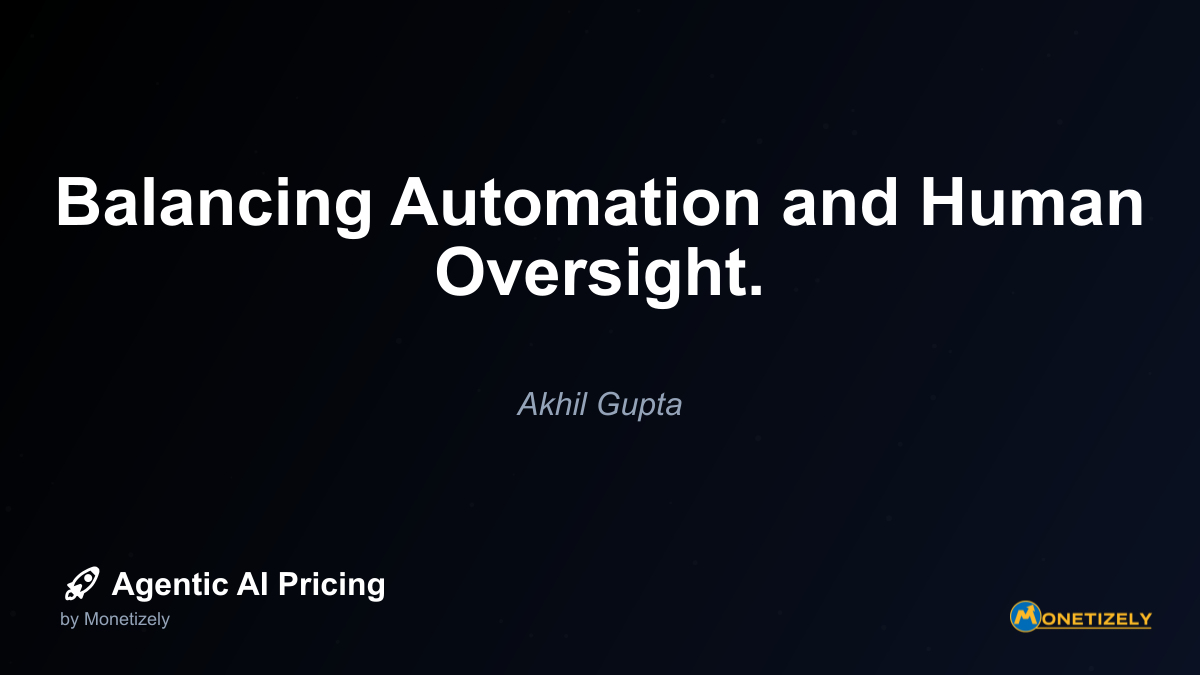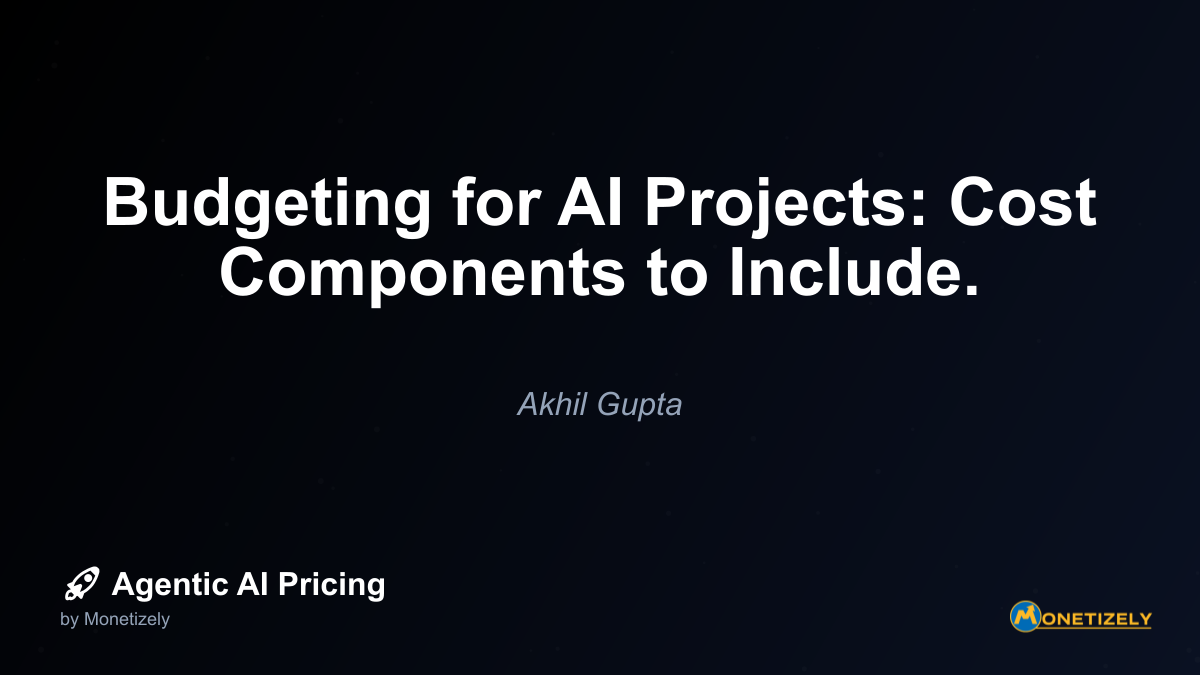· Akhil Gupta · Implementation Strategies · 8 min read
Monitoring AI Agent Performance: Metrics and Tools.
AI and SaaS Pricing Masterclass
Learn the art of strategic pricing directly from industry experts. Our comprehensive course provides frameworks and methodologies for optimizing your pricing strategy in the evolving AI landscape. Earn a professional certification that can be imported directly to your LinkedIn profile.
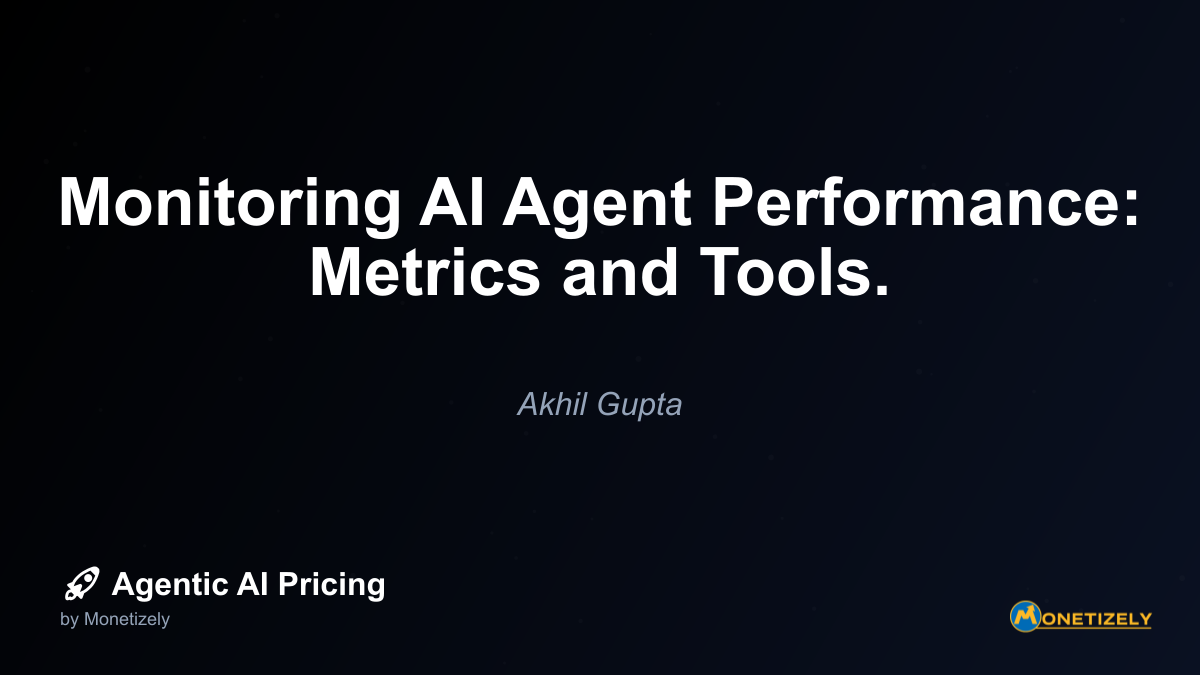
Ensuring your AI agents operate at peak performance requires comprehensive monitoring and the right metrics. Businesses implementing agentic AI systems need visibility into how these systems function in real-time to maintain quality service and quickly address any issues that arise.
Why AI Agent Performance Monitoring Matters
The deployment of AI agents within business operations represents a significant investment—one that demands careful oversight. Unlike traditional software systems, agentic AI operates with degrees of autonomy that introduce unique monitoring challenges. When these systems underperform or behave unexpectedly, the consequences can range from minor customer frustration to significant operational disruptions.
Performance monitoring serves as the nervous system for your AI implementation. It provides the essential feedback loop that allows for continuous improvement, helps identify potential issues before they impact users, and ultimately ensures that your AI agents deliver consistent value. Without robust monitoring, businesses operate their AI systems essentially blindfolded, unable to verify whether these sophisticated tools are actually delivering on their promised benefits.
Moreover, as AI agents take on increasingly critical business functions—from customer service to complex decision-making processes—the stakes of poor performance grow higher. A comprehensive monitoring strategy becomes not just good practice but an essential business safeguard.
Essential AI Agent Performance Metrics
Developing an effective monitoring framework begins with identifying the right metrics. While specific measurements may vary based on your implementation, several core metrics apply to virtually all AI agent deployments:
Accuracy Rates
Accuracy represents how often your AI agent produces correct outputs or takes appropriate actions. This metric can be broken down into several components:
- Task Completion Rate: The percentage of assigned tasks the agent successfully completes without human intervention
- Error Rate: Frequency of incorrect responses or actions
- Confidence Scores: The agent’s self-assessed probability that its response is correct
For customer-facing implementations, accuracy directly impacts user satisfaction and trust. For internal operations, it affects employee adoption and operational efficiency. Monitoring accuracy trends over time can reveal degradation in performance that might indicate model drift or changing user behaviors.
Response Time Metrics
Speed matters in AI interactions, particularly in customer-facing scenarios where user expectations for response times continue to rise. Key time-based metrics include:
- Average Response Time: How long it typically takes for the agent to process a request and generate a response
- Processing Latency: Time required for computation and decision-making
- Time to First Response: How quickly the agent acknowledges user input
- Resolution Time: Total time from initial request to complete resolution
These metrics should be tracked across different request types and complexity levels. Sudden increases in response times can indicate resource constraints, inefficient processes, or growing complexity in user requests.
Utilization and Workload
Understanding how your AI agents are being used provides critical context for performance analysis:
- Query Volume: Total number of requests processed
- Peak Usage Periods: Times when the system experiences highest demand
- Request Distribution: Types of tasks or queries being handled
- Concurrent Users/Sessions: Number of simultaneous interactions
These metrics help organizations right-size their AI implementations, identify capacity issues, and understand evolving usage patterns that might require adjustments to the underlying models.
Conversation Quality Metrics
For conversational AI agents, the quality of interactions goes beyond simple accuracy measures:
- Conversation Length: Number of turns in a typical interaction
- Topic Coherence: How well the agent maintains context throughout a conversation
- Clarification Requests: How often the agent needs to ask for additional information
- Sentiment Analysis: Tracking user emotion throughout interactions
These metrics help identify friction points in conversations and opportunities to streamline interactions through improved prompting or context handling.
Business Impact Metrics
Ultimately, AI agents must deliver business value. These metrics connect performance to outcomes:
- Conversion Rates: For sales or marketing agents
- Cost Savings: Compared to human-only processes
- Customer Satisfaction Scores: Direct feedback on agent interactions
- Retention Impact: How agent performance affects customer retention
By linking performance metrics to business outcomes, organizations can better justify continued investment in AI capabilities and prioritize improvements that deliver the greatest impact.
Advanced Performance Indicators
Beyond the fundamental metrics, sophisticated AI implementations benefit from more nuanced performance indicators:
Hallucination Detection
AI hallucinations—when agents generate plausible but factually incorrect information—represent a significant risk for businesses. Monitoring should include:
- Factual Consistency Scores: Measuring adherence to established facts
- Citation Accuracy: Verifying that referenced information exists and supports claims
- Contradiction Detection: Identifying logical inconsistencies in responses
These metrics often require human review or specialized verification systems that compare agent outputs against trusted knowledge bases.
Drift Monitoring
AI agent performance can degrade over time as usage patterns or underlying data change—a phenomenon known as model drift:
- Concept Drift: Changes in the relationship between inputs and outputs
- Data Drift: Changes in the statistical properties of input data
- Performance Drift: Gradual degradation in accuracy or other metrics
Regular monitoring for these drift patterns enables proactive model updates before performance issues become apparent to users.
Fairness and Bias Metrics
Ethical AI implementation requires ongoing monitoring for biased or unfair outcomes:
- Demographic Parity: Ensuring consistent performance across different user groups
- Equal Opportunity Measures: Verifying that false negative/positive rates remain balanced
- Representation Metrics: Tracking how different groups or viewpoints are represented in outputs
These metrics help organizations maintain ethical AI use and avoid potential reputational or regulatory issues.
Real-Time Monitoring Tools and Platforms
Implementing comprehensive AI monitoring requires specialized tools designed for the unique challenges of agentic systems:
Observability Platforms
Several platforms offer comprehensive monitoring capabilities specifically designed for AI systems:
- Arize AI: Provides ML observability with particular strength in tracking model performance and data drift
- Weights & Biases: Offers experiment tracking and visualization tools for model performance
- Fiddler AI: Specializes in explainable AI monitoring with strong bias detection capabilities
- WhyLabs: Features automated AI monitoring with anomaly detection and data quality checks
- Aporia: Delivers continuous monitoring with customizable alerts and performance dashboards
These platforms typically integrate with major cloud providers and ML frameworks, making implementation relatively straightforward for technical teams.
Open-Source Monitoring Solutions
For organizations with strong technical capabilities, open-source tools offer flexible, customizable monitoring options:
- Prometheus: Industry-standard for metrics collection and alerting
- Grafana: Visualization and dashboarding for performance metrics
- MLflow: Tracking experiments and model versions
- Seldon Core: Monitoring for Kubernetes-deployed models
- ELK Stack: Log analysis and visualization for AI systems
These tools often require more configuration and maintenance than commercial platforms but provide greater flexibility and cost advantages for large-scale deployments.
Custom Monitoring Frameworks
Many organizations implement custom monitoring solutions tailored to their specific AI implementations. These typically combine:
- Logging Infrastructure: Capturing detailed information about agent operations
- Metrics Collection Systems: Aggregating performance data across deployments
- Alerting Mechanisms: Notifying teams when metrics fall outside acceptable ranges
- Visualization Dashboards: Providing intuitive interfaces for performance analysis
Custom frameworks allow for precise alignment with business needs but require significant development and maintenance resources.
Implementation Best Practices
Effective AI agent monitoring requires more than just selecting the right tools—it demands thoughtful implementation:
Establishing Performance Baselines
Before meaningful monitoring can begin, organizations must establish clear performance baselines:
- Initial Training Metrics: Document performance during development and training
- Controlled Testing Results: Measure performance in controlled environments
- Early Production Benchmarks: Establish baseline metrics during initial deployment
- Competitive Benchmarks: Where available, compare against industry standards
These baselines provide the reference points against which ongoing performance can be measured, making it possible to detect subtle degradation or improvement.
Setting Alert Thresholds
Not all performance variations require immediate attention. Effective monitoring systems establish appropriate thresholds:
- Critical Alerts: Immediate notification for severe performance issues
- Warning Alerts: Notification of concerning trends that don’t require immediate action
- Informational Alerts: Regular updates on performance metrics
These thresholds should be calibrated based on the business impact of performance variations, with more critical functions warranting tighter thresholds.
Creating a Monitoring Cadence
Different metrics require different monitoring frequencies:
- Real-Time Monitoring: Immediate performance issues affecting users
- Daily Reviews: Overall performance trends and anomalies
- Weekly Analysis: Deeper dives into specific performance areas
- Monthly Assessments: Comprehensive performance reviews with stakeholders
This layered approach ensures that critical issues receive immediate attention while still maintaining the broader perspective needed for continuous improvement.
Responding to Performance Issues
Monitoring only delivers value when coupled with effective response mechanisms:
Troubleshooting Common Performance Problems
When monitoring reveals issues, teams should have established protocols for addressing common problems:
- Resource Constraints: Scaling computational resources to address latency
- Data Quality Issues: Identifying and correcting problematic inputs
- Model Degradation: Retraining or fine-tuning underperforming models
- Integration Failures: Resolving connectivity issues with dependent systems
Documented response playbooks speed resolution and ensure consistent handling of recurring issues.
Continuous Improvement Processes
Beyond reactive troubleshooting, monitoring data should feed into ongoing improvement:
- Regular Model Updates: Scheduled retraining based on performance data
- A/B Testing: Comparing performance of alternative approaches
- Feedback Loops: Incorporating user feedback into performance assessments
- Cross-Functional Reviews: Bringing together technical and business stakeholders to evaluate performance
These processes transform monitoring from a defensive measure into a driver of continuous enhancement.
Future Trends in AI Agent Monitoring
As AI agent technology evolves, monitoring approaches are similarly advancing:
Autonomous Monitoring Systems
The next generation of monitoring tools will leverage AI to monitor AI:
- Self-Healing Systems: Automatically addressing common performance issues
- Predictive Monitoring: Forecasting potential issues before they occur
- Intelligent Alerting: Using context to determine alert severity and routing
These capabilities will reduce the operational burden of maintaining complex AI systems.
Standardization and Regulation
As AI use expands, monitoring will increasingly be shaped by emerging standards:
- Industry Benchmarks: Common performance metrics across similar applications
- Regulatory Requirements: Mandated monitoring for high-risk AI applications
- Certification Standards: Third-party verification of monitoring adequacy
Organizations that establish robust monitoring now will be better positioned to adapt to these emerging requirements.
Conclusion
Comprehensive performance monitoring forms the foundation of successful AI agent implementations. By tracking the right metrics, implementing appropriate tools, and establishing effective response mechanisms, organizations can ensure their AI investments deliver consistent value while minimizing risks.
The most successful implementations treat monitoring not as a technical afterthought but as an essential business function that connects AI performance directly to organizational outcomes. As AI agents take on increasingly critical roles, the sophistication and importance of monitoring will only grow.
For organizations just beginning their AI journey, start with the fundamental metrics outlined here and a monitoring solution appropriate to your scale and technical capabilities. For those with established implementations, consider how more advanced monitoring approaches might help identify subtle performance issues and opportunities for improvement.
In either case, remember that effective monitoring is not a one-time implementation but an ongoing commitment to visibility, accountability, and continuous enhancement of your AI systems.
Co-Founder & COO
Akhil is an Engineering leader with over 16+ years of experience in building, managing and scaling web-scale, high throughput enterprise applications and teams. He has worked with and led technology teams at FabAlley, BuildSupply and Healthians. He is a graduate from Delhi College of Engineering and UC Berkeley certified CTO.
Pricing Strategy Audit
Let our experts analyze your current pricing strategy and identify opportunities for improvement. Our data-driven assessment will help you unlock untapped revenue potential and optimize your AI pricing approach.

